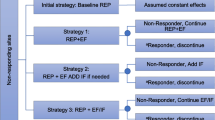Abstract
Failure to apply research on effective interventions spans all areas of medicine, including children’s mental health services. This article examines the policy, structural, and economic problems in which this gap originates. We identify four steps to close this gap. First, the field should develop scientific measures of the research-practice gap. Second, payors should link incentives to outcomes-based performance measures. Third, providers and others should develop improved understanding and application of effective dissemination and business models. Fourth, efforts to link EBP to clinical practice should span patient/consumers, providers, practices, plans, and purchasers. The paper discusses each of these in turn and relates them to fundamental problems of service delivery.



Similar content being viewed by others
References
Bremer, R. W., Scholle, S. H., Keyser, D., Knox Houtsinger, J. V., & Pincus, H. A. (2008). Pay for performance in behavioral health. Psychiatric Services, 59, 1419–1429.
Coleman, K., Austin, B. T., Brach, C., & Wagner, E. M. (2009). Evidence on the Chronic Care Model in the new millennium. Health Affairs, 28, 75–85.
Epstein, A. M. (2007). Pay for performance at the tipping point. The New England Journal of Medicine, 356, 515–517.
Fixsen, D. L., Naoom, S. F., Blasé, K. A., Friedman, R. M., & Wallace, F. (2005). Implementation research: A synthesis of the literature. Tampa, FL: University of South Florida, Louis de la Parte Florida Mental Health Institute, The National Implementation Network (FMHI Publication #231) (Available from http://nirn.fmhi.usf.edu/.
Forman, S. G., Olin, S. S., Hoagwood, K. E., Crowe, M., & Saka, N. (2010). Evidence-based interventions in schools: developers’ views of implementation barriers and facilitators. School Mental Health (in press).
Gilmore, A. S., Zhao, Y., Kang, N., Ryskina, K. L., Legorreta, A. P., & Taira, D. A. (2007). Patient outcomes and evidence-based medicine in a preferred provider organization setting: A six-year evaluation of a physician pay-for-performance program. Health Services Research, 42, 2140–2159. 2294–2323.
Grossbart, S. R. (2006). What’s the return? Assessing the effect of “pay-for-performance” initiatives on the quality of care delivery. Medical Care Research and Review, 63(Suppl), 29S–48S.
Henderson, J. L., MacKay, S., & Peterson-Badali, M. (2006). Closing the research–practice gap: Factors affecting adoption and implementation of a children’s mental health program. Journal of Clinical Child Adolescent Psychology, 35, 2–12.
Hoagwood, K., Burns, B. J., Kiser, L., Ringeisen, H., & Schoenwald, S. K. (2001). Evidence-based practice in child and adolescent mental health services. Psychiatric Services, 52, 1179–1189.
Institute of Medicine. (2001). Crossing the quality chasm: A new health system for the 21st century. Washington, DC: National Academy of Medicine Press.
Jamtvedt, G., Young, J. M., Kristoffersen, D. T., Thomson O’Brien, M. A., & Oxman, A. D. (2003) Audit and feedback: Effects on professional practice and health care outcomes. Cochrane Database of Systematic Review (3), CD000259.
Jensen, P. S. (2007). For the MTA Cooperative Group: 3-Year follow-up of the NIMH MTA study. Journal of the American Academy of Child and Adolescent Psychiatry, 46, 988–1001.
Jensen, P. S., Garcia, J. A., Glied, S., Crowe, M., Foster, M., Schlander, M., et al. (2005). Cost-effectiveness of ADHD treatments: Findings from the MTA study. The American Journal of Psychiatry, 162, 1628–1636.
Kazdin, A. E., & Kendall, P. C. (1998). Current progress and future plans for developing effective treatments: Comments and perspectives. Journal of Clinical Child Psychology, 27, 217–226.
McLennan, J. D., Wathen, C. N., MacMillan, H. L., & Lavis, J. N. (2006). Research-practice gaps in child mental health. Journal of the American Academy of Child and Adolescent Psychiatry, 45, 658–665.
MTA Cooperative Group. (1999). A 14-month randomized clinical trial of treatment strategies for attention deficit hyperactivity disorder. Archives of General Psychiatry, 56, 1073–1086.
National Committee for Quality Assurance (NCQA). (2008). The state of health care quality 2008: Industry trends and analysis. Washington (DC): National Committee for Quality Assurance (NCQA); 2008. 131 p. Also accessible online at http://www.ncqa.org/tabid/858/Default.aspx, accessed November 24, 2009.
Owens, E. B., Hinshaw, S. P., Kraemer, H. C., Arnold, L. E., Abikoff, H. B., Cantwell, D. P., et al. (2003). Which treatment for whom for ADHD? Moderators of treatment response in the MTA. Journal of Abnormal Child Psychology, 71, 540–552.
Shortell, S. M. (2004). Increasing value: A research agenda for addressing the managerial and organizational challenges facing health care delivery in the United States. Medical Care Research and Review, 61(3 Suppl), 12S–30S.
Swanson, J. M. (2007). For the MTA Cooperative Group: Secondary evaluations of the MTA 36-month outcomes: Propensity score and growth mixture model analyses. Journal of the American Academy of Child and Adolescent Psychiatry, 46, 1002–1013.
Volpp, K. G., John, L. K., Troxel, A. B., Norton, L., Fassbender, J., & Loewenstein, G. (2008). Financial incentive-based approaches for weight loss: A randomized trial. JAMA, 300, 2631–2637.
Weisz, J. R., Donenberg, G., Han, S., & Weiss, B. (1995). Bridging the gap between laboratory and clinic in child and adolescent psychotherapy. Journal of Consulting Clinical Psychology, 63, 688–701.
Author information
Authors and Affiliations
Corresponding author
Rights and permissions
About this article
Cite this article
Jensen, P.S., Foster, M. Closing the Research to Practice Gap in Children’s Mental Health: Structures, Solutions, and Strategies. Adm Policy Ment Health 37, 111–119 (2010). https://doi.org/10.1007/s10488-010-0286-z
Published:
Issue Date:
DOI: https://doi.org/10.1007/s10488-010-0286-z




